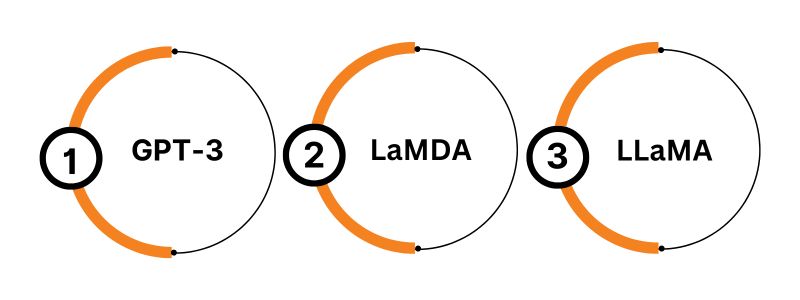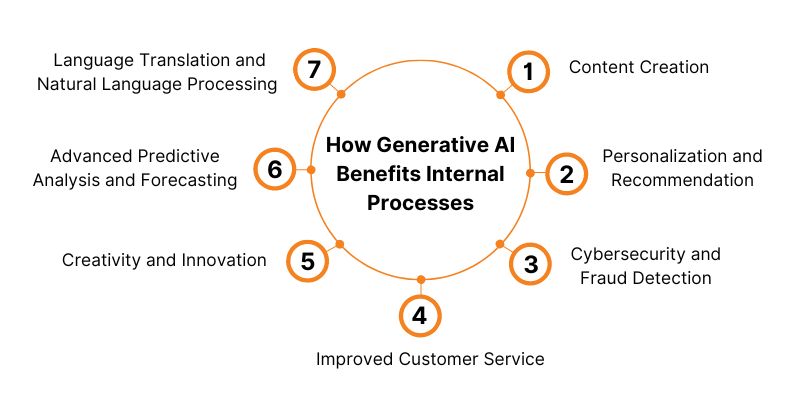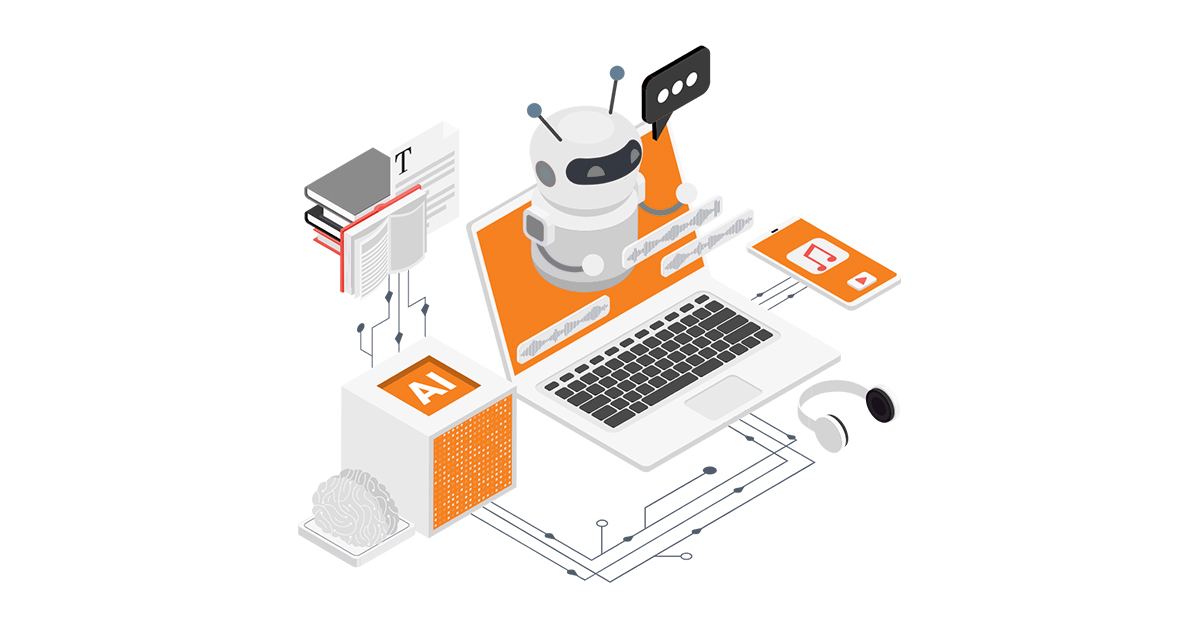Generative AI is the new digital genie, ready to perform different activities that blur the lines between human and machine creation. From crafting tailor-made experiences that seem to read your mind to pushing the boundaries of innovation, it’s like having a tech-savvy sorcerer at your service.
But here’s the twist. As we journey through these Generative AI wonders, you’ll also navigate through the fog of biases that algorithms can unknowingly carry. But that shouldn’t stop you from adopting Generative AI to streamline your internal processes.
Therefore, in this blog, we will discuss all the benefits of Generative AI and some potential issues that may arise so you can be prepared.
Let’s dive in!
What Is Generative AI?
Generative AI involves a set of sophisticated algorithms with the remarkable ability to craft seemingly novel and authentic content, spanning text, images, and even audio. These algorithms achieve this by drawing upon their training data. The most potent among them are constructed upon foundational models, which undergo self-supervised training on vast amounts of unlabeled data. This process enables these models to discern hidden patterns applicable to various tasks.
For instance, take GPT-3.5—a foundational model fine-tuned on extensive textual data. It can be repurposed to address queries, condense text into summaries, or gauge sentiment. Another example is DALL-E, a foundation model that bridges text and images. It can be adapted to craft images, magnify existing visuals, or produce fresh interpretations of established artworks.
Types of Generative AI
Types Of Text Models

GPT-3
One notable contender is GPT-3, known as Generative Pretrained Transformer 3. This autoregressive model is honed through extensive exposure to a vast text corpus, equipping it to effortlessly produce high-quality natural language content. GPT-3’s adaptability shines as it can be finely tuned to excel in diverse language tasks, such as language translation, summarization, and tackling questions.
LaMDA
Another entrant is LaMDA or Language Model for Dialogue Applications. This transformer-based language model mirrors GPT’s prowess in generating top-tier natural language text. However, LaMDA differentiates itself by focusing on dialogue contexts, allowing it to grasp the nuances of open-ended conversations more adeptly.
LLaMA
An intriguing addition is LLaMA, which stands as a compact yet potent player in natural language processing models. While it follows the autoregressive transformer paradigm like GPT-4 and LaMDA, LLaMA’s strategy involves training on a more extensive token range. This tactic enhances its performance potential while keeping its parameter count modest.
These diverse Generative AI models have paved the way for many Generative AI services and garnered the attention of numerous pioneering Generative AI companies.
Types Of Multimodal Models
In this leading pack is GPT-4, the latest iteration within the GPT series. This expansive multimodal marvel embraces textual and visual inputs, seamlessly generating textual outputs. A transformer-based framework underpins GPT-4’s architecture, having undergone extensive pretraining to predict subsequent tokens within a document. GPT-4 leaps forward regarding factual accuracy and adherence to predefined behavior through a subsequent alignment process.
DALL-E
DALL.E stands as a remarkable multimodal algorithm capable of traversing diverse data modalities. It can conjure unprecedented images and artwork from natural language textual prompts, showcasing its unique creative prowess.
Stable Diffusion
Similarly, Stable Diffusion shines as a text-to-image model akin to DALL.E. However, it distinguishes itself by employing a process termed “diffusion.” This technique gradually diminishes noise within an image, flawlessly molding it to match the accompanying textual description.
Taking a leap into a specialized domain, Progen emerges as a versatile multimodal entity. By training on an extensive pool of 280 million protein samples, Progen can ingeniously fabricate proteins aligning with specific properties dictated through natural language input.
How Generative AI benefits internal processes

1. Content Creation
Generative AI revolutionizes content creation by automating the production of text, images, and even audio materials. This alleviates the burden on internal creative teams, freeing them to focus on higher-level tasks. Companies working on AI product development can leverage Generative AI to generate consistent, high-quality content without exhausting resources.
2. Personalization and Recommendation
Generative AI models can analyze vast amounts of customer data to create personalized recommendations. This enhances customer experiences by suggesting products or services that align with individual preferences. Internal AI development teams can employ Generative AI to craft recommendation engines that boost customer engagement and satisfaction.
3. Cybersecurity and Fraud Detection
Generative AI excels in identifying patterns and anomalies. In the realm of cybersecurity, it can swiftly detect unusual behaviors, potential threats, or fraudulent activities. This proactive approach safeguards sensitive data and prevents breaches. Companies specializing in Generative AI technologies play a pivotal role in fortifying internal security measures.
4. Improved Customer Service
Generative AI-powered chatbots and virtual assistants provide instantaneous customer support. They can understand and respond to customer queries in a human-like manner, enhancing user experiences and reducing response times. This improves customer satisfaction and frees up human resources for more complex tasks.
5. Creativity and Innovation
Generative AI nurtures innovation by generating fresh ideas, designs, and concepts. It can serve as a creative partner, suggesting novel directions for product development. Organizations collaborating with Generative AI companies can infuse a new dimension of innovation into their internal ideation processes.
6. Advanced Predictive Analysis and Forecasting
Generative AI models process historical and real-time data to predict future trends and outcomes. This aids in strategic decision-making, supply chain optimization, and financial planning. Internal AI teams leverage these capabilities to provide accurate insights for informed business choices.
7. Language Translation and Natural Language Processing
Generative AI shines in translating text from one language to another while preserving context and nuance. Moreover, it powers natural language processing, enabling sentiment analysis, text summarization, and language understanding. Companies focusing on Generative AI contribute significantly to breaking language barriers and enhancing internal communication and operations.
These transformative capabilities emphasize the role of Generative AI in reshaping internal processes, allowing businesses to collaborate effectively with AI development teams and Generative AI companies to unlock new levels of efficiency, innovation, and customer satisfaction.
[Also Read: Advantages of AI & Machine Learning in Software Development]
Threats associated with Generative AI
1. Bias
Generative AI models learn from the data they’re trained on, which can inadvertently perpetuate biases present in that data. This leads to biased outputs that reflect existing societal prejudices or discriminatory practices. AI product development teams must be vigilant in identifying and mitigating bias to ensure fairness and equity in the generated content, recommendations, and decisions.
2. Hallucination
Generative AI models, despite their remarkable capabilities, can sometimes produce content that needs to be more accurate or nonsensical. This is known as “hallucination.” These generated outputs seem plausible but lack any factual basis. AI development teams must implement mechanisms to detect and prevent such instances, particularly in critical applications like medical diagnosis or legal document generation.
[Also Read: How to Integrate Machine Learning and AI into Apps]
3. Cybersecurity and Fraud
While Generative AI enhances cybersecurity in some aspects, it can also pose risks. Hackers and malicious actors might exploit AI-generated content to create convincing phishing emails or false documents, leading to cyberattacks and fraud. AI product development must involve robust security measures to prevent the misuse of AI-generated content for malicious purposes.
4. Lack of Transparency
Generative AI models are often complex, and their decision-making processes can be challenging to decipher. This lack of transparency can make it difficult to understand how and why a model arrives at a particular output. This opacity raises concerns, especially when the decisions have significant implications. AI development teams should prioritize explainable AI techniques to clarify and ensure accountability.
Harness the Power of Generative AI with Netsmartz
At Netsmartz, we offer a dedicated team of AI software developers who are skilled in navigating the complexities of Generative AI. Our expertise extends to crafting AI solutions that prioritize transparency, fairness, and security, ensuring that the transformative power of Generative AI is harnessed responsibly. When you partner with Netsmartz, you gain access to a wealth of experience and a commitment to excellence in AI. Contact us to elevate your business through the strategic implementation of Generative AI while prioritizing ethics, security, and innovation.
Take your Business Beyond Boundaries with Generative AI
Request Free Consultation
Summary
Kickstart Your Project With Us!
Popular Posts
CONTACT US
Let's Build Your Agile Team.
Experience Netsmartz for 40 hours - No Cost, No Obligation.
Connect With Us Today!
Please fill out the form or send us an email to







